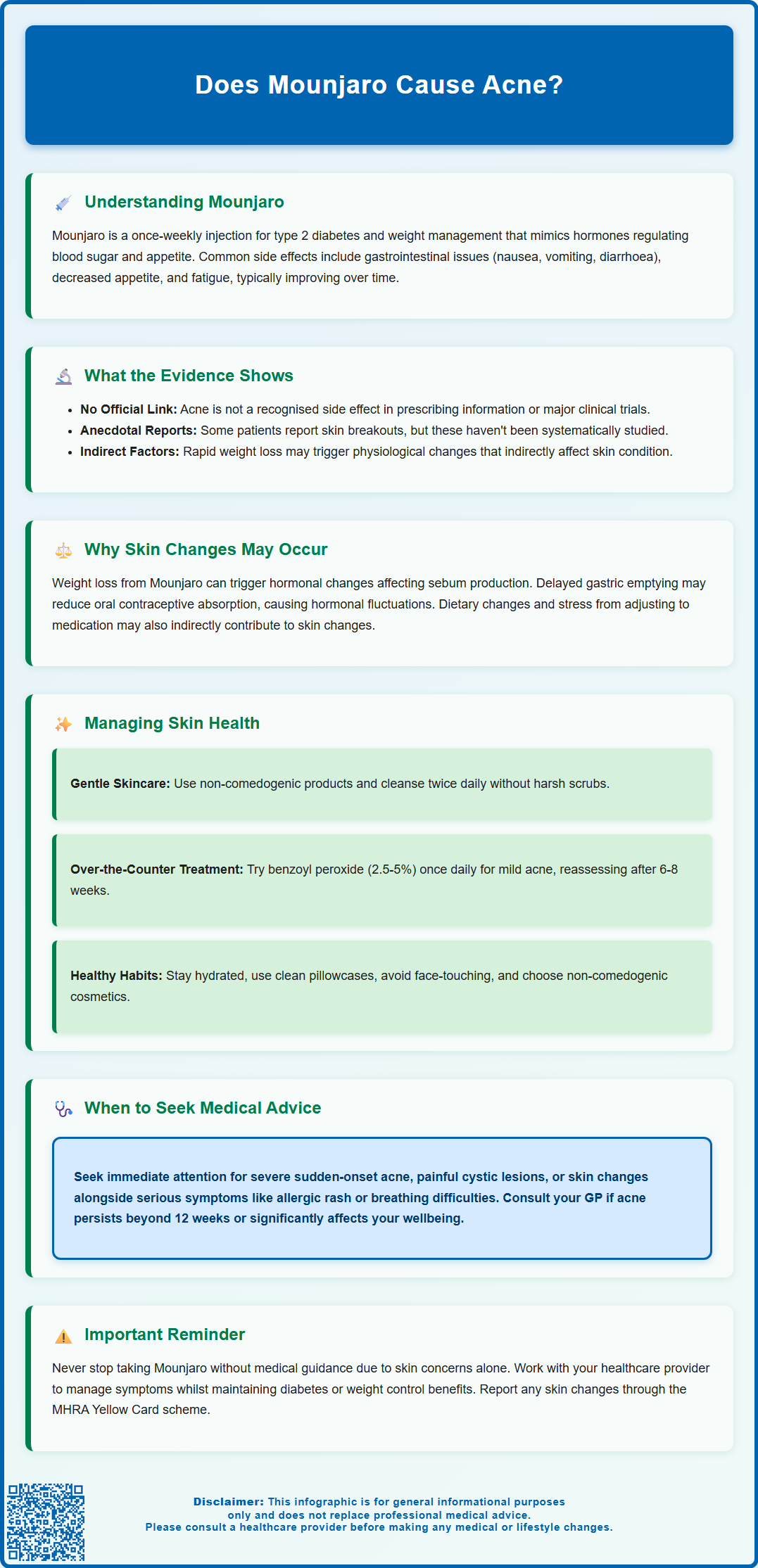
Does Mounjaro cause acne? This is a question some patients ask when starting tirzepatide treatment for type 2 diabetes or weight management. Mounjaro (tirzepatide) is a dual GIP and GLP-1 receptor agonist licensed in the UK, known primarily for gastrointestinal side effects such as nausea and diarrhoea. Acne is not listed as a recognised adverse effect in UK prescribing information or major clinical trials. However, some individuals report skin changes during treatment. This article examines the evidence, explores potential mechanisms, and provides practical guidance on managing skin health whilst taking Mounjaro.
Summary: Acne is not an established side effect of Mounjaro (tirzepatide) according to UK prescribing information and clinical trial data.
Mounjaro (tirzepatide) is a prescription medication licensed in the UK for the treatment of type 2 diabetes mellitus and, more recently, for weight management in adults with obesity or overweight with weight-related comorbidities. As a dual glucose-dependent insulinotropic polypeptide (GIP) and glucagon-like peptide-1 (GLP-1) receptor agonist, Mounjaro works by mimicking naturally occurring hormones that regulate blood sugar levels and appetite. It is administered once weekly via subcutaneous injection and has demonstrated significant efficacy in improving glycaemic control and promoting weight loss in clinical trials (SURPASS and SURMOUNT programmes).
Like all medications, Mounjaro is associated with a range of side effects, which vary in frequency and severity among individuals. The most commonly reported adverse effects include gastrointestinal symptoms such as nausea, vomiting, diarrhoea, constipation, and abdominal discomfort. These effects are typically most pronounced during the initial weeks of treatment or following dose escalation, and often diminish as the body adjusts to the medication. Other frequently observed side effects include decreased appetite, fatigue, and injection site reactions such as redness or mild swelling.
Importantly, hypoglycaemia (low blood sugar) can occur when Mounjaro is used with insulin or sulfonylureas, and dose adjustments of these medications may be required. Mounjaro also delays gastric emptying, which can reduce the absorption of oral medications, including combined oral contraceptives. Additional contraceptive measures are advised for 4 weeks after initiation and after each dose escalation.
According to the Summary of Product Characteristics (SmPC) approved by the Medicines and Healthcare products Regulatory Agency (MHRA), the safety profile of Mounjaro has been extensively evaluated in clinical trials involving thousands of participants. Understanding the established side effect profile is essential when evaluating whether less commonly reported symptoms, such as skin changes including acne, may be genuinely associated with Mounjaro treatment or represent coincidental occurrences.

Currently, there is no official established link between Mounjaro (tirzepatide) and the development or worsening of acne in the approved prescribing information or major clinical trial data. Acne is not listed among the recognised adverse effects in the UK SmPC for Mounjaro, nor has it been identified as a significant concern in the pivotal SURPASS clinical trial programme for diabetes or the SURMOUNT programme for weight management that supported the medication's regulatory approval. This suggests that if a relationship exists, it is either extremely rare or has not been definitively established through controlled clinical research.
However, it is important to acknowledge that post-marketing surveillance and patient-reported experiences sometimes reveal side effects that were not apparent during pre-approval clinical trials. Some individuals taking Mounjaro have anecdotally reported skin changes, including breakouts or acne-like lesions, though these reports remain limited and have not been systematically studied. The absence of acne from official documentation does not categorically rule out the possibility of idiosyncratic reactions in susceptible individuals, but it does indicate that such occurrences are not common or consistent enough to warrant inclusion in regulatory guidance.
When evaluating patient concerns about acne during Mounjaro treatment, healthcare professionals must consider alternative explanations. These may include coincidental timing with other factors known to influence skin health, such as dietary changes associated with weight loss, hormonal fluctuations, stress, or the use of other medications or skincare products. Additionally, rapid weight loss itself—a common outcome of Mounjaro therapy—can trigger various physiological changes that may indirectly affect skin condition. A thorough clinical assessment is essential to distinguish between genuine drug-related effects and other contributing factors.
If you suspect Mounjaro may be causing skin changes, you should report this as a potential side effect through the MHRA Yellow Card scheme (yellowcard.mhra.gov.uk or via the Yellow Card app).
Although acne is not a recognised side effect of Mounjaro, several potential mechanisms could theoretically influence skin health, though these remain hypothetical without tirzepatide-specific evidence. Significant weight loss, which many patients experience whilst taking Mounjaro, triggers substantial metabolic and hormonal changes throughout the body. Adipose tissue is metabolically active and produces various hormones and inflammatory mediators; as fat mass decreases, alterations in hormone levels—including sex hormones and insulin—may occur. These hormonal shifts could potentially affect sebum production and skin cell turnover, factors that contribute to acne development in susceptible individuals.
One important consideration is that Mounjaro delays gastric emptying, which can reduce the absorption of oral medications, including combined oral contraceptives. The MHRA SmPC advises that additional contraceptive measures should be considered for 4 weeks after initiation and after each dose escalation. Reduced contraceptive efficacy could potentially lead to hormonal fluctuations that might affect skin health in some individuals.
Furthermore, dietary modifications often accompany Mounjaro treatment, both as a result of the medication's appetite-suppressing effects and as part of comprehensive lifestyle interventions for diabetes or weight management. Changes in nutritional intake, particularly variations in carbohydrate consumption or overall caloric restriction, have been associated with skin changes in some individuals. The relationship between diet and acne remains an area of ongoing research, but certain dietary patterns may influence inflammatory processes and hormonal balance relevant to skin health.
Gastrointestinal disturbances, the most common side effects of Mounjaro, may also indirectly impact skin condition. Additionally, the stress of managing side effects or adjusting to a new medication regimen may contribute to stress-related skin changes. Injection site reactions typically occur at the site of administration (abdomen, thigh, or upper arm) and have distinct characteristics from acne, making confusion between the two unlikely in most cases.
For patients concerned about skin changes whilst taking Mounjaro, implementing a consistent skincare routine can help maintain skin health and potentially minimise breakouts. A gentle, non-comedogenic cleansing regimen twice daily removes excess oil, dirt, and bacteria without over-stripping the skin's natural protective barrier. Patients should avoid harsh scrubs or aggressive cleansing, which can irritate the skin and paradoxically worsen acne. Moisturisers labelled as 'non-comedogenic' or 'oil-free' are less likely to clog pores and are generally suitable for acne-prone skin.
For mild acne, over-the-counter treatments containing benzoyl peroxide (2.5-5%) can be appropriate as a first-line treatment, in line with NHS guidance. Apply once daily initially and monitor for skin irritation. If using benzoyl peroxide, be aware it can bleach clothing and bedding. Reassess after 6-8 weeks of consistent use.
Lifestyle factors play a crucial role in supporting overall skin health during Mounjaro treatment. Adequate hydration is essential, particularly given the gastrointestinal side effects that may lead to fluid loss. Patients should aim for sufficient water intake throughout the day. A balanced, nutrient-rich diet that supports the medication's therapeutic goals is recommended. Regular, gentle exercise promotes circulation and stress reduction, both of which can positively influence skin condition, though patients should shower promptly after sweating to prevent pore blockage.
Simple measures such as:
Using clean pillowcases and towels regularly
Avoiding touching or picking at the face
Choosing non-comedogenic cosmetics and sunscreen
Managing stress through appropriate techniques
Maintaining consistent sleep patterns
These practical steps can support skin health without interfering with Mounjaro therapy. If acne persists despite these measures for 12 weeks or is causing significant distress, consult your GP. They may recommend prescription options such as topical retinoids, topical antibiotics (in combination), or oral therapies as appropriate. Patients should maintain open communication with their healthcare team about any skin changes.
Whilst mild skin changes during Mounjaro treatment may not require immediate medical intervention, certain circumstances warrant prompt consultation with a GP or prescribing clinician. Patients should seek medical advice if they experience severe, sudden-onset acne that significantly differs from any previous skin concerns, particularly if accompanied by other symptoms such as fever, malaise, or signs of infection. Painful, deep cystic lesions or widespread inflammatory acne may require specialist dermatological assessment and treatment to prevent scarring and address underlying causes.
Patients should also contact their healthcare provider if skin changes are accompanied by other concerning symptoms that might indicate a more serious adverse reaction. These include:
Severe injection site reactions with spreading redness, warmth, or swelling
Rash or hives suggesting an allergic response
Anaphylaxis (facial swelling, breathing difficulty, collapse)
Skin changes associated with signs of pancreatitis (severe abdominal pain radiating to the back)
Symptoms suggestive of thyroid tumours (neck mass, difficulty swallowing, persistent hoarseness, breathing difficulties)
Rapidly spreading cellulitis at injection site or blistering/mucosal rash
Persistent skin problems that significantly impact quality of life or psychological wellbeing
Referral to a dermatologist may be appropriate for severe nodulocystic acne, acne with scarring or risk of scarring, failure of 12 weeks of appropriate therapy, significant psychological impact, or clinical features of hyperandrogenism (e.g., hirsutism, irregular menses).
It is important to remember that not all skin changes during Mounjaro treatment are necessarily caused by the medication. A thorough medical assessment can help identify alternative causes, such as hormonal imbalances, other medications, skincare products, or underlying dermatological conditions that may have emerged coincidentally.
Patients should never discontinue Mounjaro without medical guidance due to skin concerns alone, as the medication provides important therapeutic benefits for diabetes management or weight control. Instead, a collaborative approach with healthcare providers allows for proper evaluation of the skin changes, consideration of potential contributing factors, and development of an appropriate management strategy.
If you suspect Mounjaro may be causing skin changes, report this as a potential side effect through the MHRA Yellow Card scheme (yellowcard.mhra.gov.uk or via the Yellow Card app).
No, acne is not listed as a recognised adverse effect in the UK Summary of Product Characteristics for Mounjaro or in major clinical trial data from the SURPASS and SURMOUNT programmes.
The most common side effects of Mounjaro include gastrointestinal symptoms such as nausea, vomiting, diarrhoea, constipation, and abdominal discomfort, along with decreased appetite, fatigue, and injection site reactions.
Seek medical advice if you experience severe or sudden-onset acne, painful cystic lesions, skin changes with fever or infection signs, severe injection site reactions, or symptoms affecting quality of life. Report suspected side effects via the MHRA Yellow Card scheme.
The health-related content published on this site is based on credible scientific sources and is periodically reviewed to ensure accuracy and relevance. Although we aim to reflect the most current medical knowledge, the material is meant for general education and awareness only.
The information on this site is not a substitute for professional medical advice. For any health concerns, please speak with a qualified medical professional. By using this information, you acknowledge responsibility for any decisions made and understand we are not liable for any consequences that may result.
Lorem ipsum dolor sit amet, consectetur adipiscing elit, sed do eiusmod tempor incididunt ut labore et dolore magna aliqua. Ut enim ad minim veniam, quis nostrud exercitation ullamco laboris nisi ut aliquip ex ea commodo consequat. Duis aute irure dolor in reprehenderit in voluptate velit esse cillum dolore eu fugiat nulla pariatur.
Block quote
Ordered list
Unordered list
Bold text
Emphasis
Superscript
Subscript